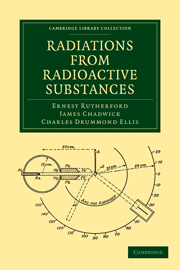Book contents
- Frontmatter
- Contents
- LIST OF PLATES
- Preface
- Chap. I Radioactive Transformations
- Chap. II The α Rays
- Chap. III Absorption of the α Rays
- Chap. IV Some Properties of the α Particle
- Chap. V Theories of Absorption of α Rays
- Chap. VI Secondary Effects produced by α Rays
- Chap. VII General Properties of the Radiations
- Chap. VIII The Scattering of α and β Particles
- Chap. IX The Collisions of α Particles with Light Atoms
- Chap. X The Artificial Disintegration of the Light Elements
- Chap. XI The Radioactive Nuclei
- Chap. XII β Ray and γ Ray Spectra
- Chap. XIII The Disintegration Electrons
- Chap. XIV The Passage of β Particles through Matter
- Chap. XV The Scattering and Absorption of γ Rays
- Chap. XVI Intensity Problems connected with the Emission of γ Rays
- Chap. XVII Atomic Nuclei
- Chap. XVIII Miscellaneous
- Appendix
- Subject Index
- Index of Names
- Plate section
Chap. VII - General Properties of the Radiations
Published online by Cambridge University Press: 07 September 2010
- Frontmatter
- Contents
- LIST OF PLATES
- Preface
- Chap. I Radioactive Transformations
- Chap. II The α Rays
- Chap. III Absorption of the α Rays
- Chap. IV Some Properties of the α Particle
- Chap. V Theories of Absorption of α Rays
- Chap. VI Secondary Effects produced by α Rays
- Chap. VII General Properties of the Radiations
- Chap. VIII The Scattering of α and β Particles
- Chap. IX The Collisions of α Particles with Light Atoms
- Chap. X The Artificial Disintegration of the Light Elements
- Chap. XI The Radioactive Nuclei
- Chap. XII β Ray and γ Ray Spectra
- Chap. XIII The Disintegration Electrons
- Chap. XIV The Passage of β Particles through Matter
- Chap. XV The Scattering and Absorption of γ Rays
- Chap. XVI Intensity Problems connected with the Emission of γ Rays
- Chap. XVII Atomic Nuclei
- Chap. XVIII Miscellaneous
- Appendix
- Subject Index
- Index of Names
- Plate section
Summary
§ 34 a. Emission of α particles and probability variations. The rate of disintegration of all radioactive substances is expressed by a simple law, namely, that the number of atoms n breaking up per second is proportional to the number n of atoms present. Consequently n = λN, where λ is a constant characteristic for a particular radioactive substance. The rate of transformation of an element has been found to be a constant under all conditions. It is unaltered by exposing the active matter to extremes of temperature or by change of its physical or chemical state. It is independent of the age of the active matter or its concentration. It is unaffected by exposure to strong magnetic fields. Hevesy has shown that the disintegration of the primary radioactive element uranium is unaltered by exposing it to the β and γ radiation from a strong source of radium, although these rays, of great individual energy, might be expected to penetrate the atomic, nucleus.
Since the expulsion of an α or β particle results from an instability of the atomic nucleus, the failure to alter the rate of transformation shows that the stability of the atomic nucleus is not influenced to an appreciable extent by the forces at our command. This is not unexpected when we consider the enormous intensity of the forces, probably both electric and magnetic, which hold the charged parts of the nucleus together in such a minute volume.
- Type
- Chapter
- Information
- Radiations from Radioactive Substances , pp. 167 - 190Publisher: Cambridge University PressPrint publication year: 2010First published in: 1930



